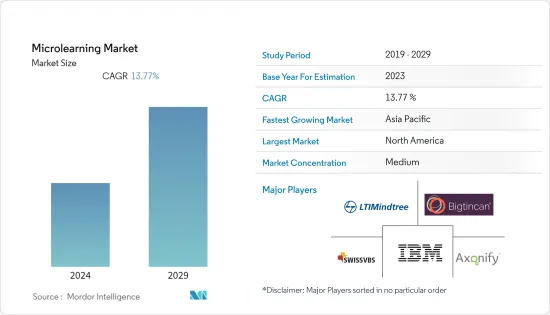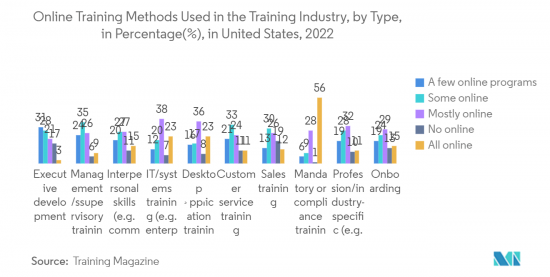 |
市場調査レポート
商品コード
1406199
マイクロラーニング:市場シェア分析、産業動向・統計、成長予測、2024年~2029年Microlearning - Market Share Analysis, Industry Trends & Statistics, Growth Forecasts 2024 - 2029 |
||||||
● お客様のご希望に応じて、既存データの加工や未掲載情報(例:国別セグメント)の追加などの対応が可能です。 詳細はお問い合わせください。
| マイクロラーニング:市場シェア分析、産業動向・統計、成長予測、2024年~2029年 |
|
出版日: 2024年01月04日
発行: Mordor Intelligence
ページ情報: 英文 120 Pages
納期: 2~3営業日
|
- 全表示
- 概要
- 目次
マイクロラーニング市場規模は、CAGR13.77%を記録し、現在の23億1,000万米ドルから今後5年間で44億米ドルに成長すると予測されています。
マイクロラーニングの利用は、職場、家庭、教育機関において急速に普及しています。NTL Institute of Applied Behavioral Scienceの学習ピラミッド・モデルによると、聞く、読む、観察するという従来の学習方法は効果がないです。人は内容の20%から30%しか思い出せないかもしれないです。シミュレーション学習に基づく技術の進歩は、学習成果の高い割合を示し、市場の成長を効果的に促進しています。

主なハイライト
- 数多くの世界組織でモバイルワーカーを訓練する必要性は、世界のマイクロラーニング市場の成長を促進する重要な要素です。もう一つの主要な市場促進要因は、企業にとって測定可能な結果をもたらす可能性のある、スキルベースで結果指向のトレーニングに対するニーズの高まりの拡大です。
- マイクロラーニングは、eラーニングに対する総合的なアプローチであり、主にトレーニングを提供するために小さな学習ユニットを使用することを扱う。マイクロラーニングは、学習者がよりよく知識を習得し、保持できるように、一口サイズの学習ナゲットを設計することを含み、それぞれが特定の学習成果を満たします。マイクロラーニングは、学習者とインストラクターにとっていくつかの利点があるため、eラーニングにおける有望な学習アプローチです。
- また、クラウドベースのソリューションの普及と利用可能性の向上も、市場の大きな促進要因となっています。クラウド・ソリューションは、従来のオンプレミス型マイクロラーニングの拡張性の限界に対処するためのプラットフォームと必要なインフラを提供します。さらに、マイクロラーニングは、顧客エンゲージメントと価値創造のためのゲーミフィケーションを含む既存のアプリケーションやプラットフォームへの導入が増加しています。
- さらに、より高い柔軟性と仕事のバリエーションに対するミレニアル世代からの要求の高まりは、定型的な長時間労働の仕事をする代わりに、頻繁にポジションを変え、異なる組織で異なるプロジェクトに従事するフリーランサーで構成されるかなりの労働力を大幅にもたらしました。したがって、これらのフリーランサーは、マイクロラーニング・ソリューション・プロバイダーの潜在的なターゲット層となっています。
- さらに、マイクロラーニングの受容性を高めるためのトレーニングや教育のゲーミフィケーションは、マイクロラーニング業界のさらなる発展の機会を生み出すと思われます。しかし、学習者のモチベーションの欠如は、マイクロラーニング市場の拡大にさらなる課題をもたらす可能性があります。
- パンデミックの間、いくつかの業界では、マイクロラーニング・アプローチを使用して、企業活動を運営するための最新技術や手順の使用方法をスタッフに教え、マイクロラーニング市場の大幅な成長につながった。マイクロラーニング・プログラムは、ビデオや音声、様々な業界の専門家の個人的な経験を活用することで、人々が新しいスキルを習得するのに役立った。COVID-19は、様々なエンドユーザー産業にマイクロラーニングの絶大な機会を提供したため、市場は長期的に成長すると思われます。
マイクロラーニング市場動向
スキルベースおよび結果指向のトレーニングに対するニーズの高まりが市場成長を牽引
- 企業は、スキルベースのプロセスが流行以来増加した困難を効果的に解決することに気づいています。雇用主は、重要なポジションに適格な応募者を採用し、採用した人材を確保するための支援を必要としています。スキルベースのアプローチを採用する企業は、募集中の職種に応募する人材の量と質を高めることができ、従業員が社内で昇進する可能性をより多く見出すことができるため、雇用者の定着率を高めることができます。
- さらに、ミレニアル世代がより高い柔軟性と仕事のバリエーションを求めるようになったことで、定型的な長時間労働ではなく、頻繁に職を変え、さまざまな組織でさまざまなプロジェクトに携わるフリーランサーで構成される労働力が大幅に増加しました。したがって、これらのフリーランサーは、マイクロラーニング・ソリューション・プロバイダーの潜在的なターゲット層となっています。
- スキルベースの方法は、企業が長期的にこれらの役割を果たすのに適した人材で構成される、より多くの人材プールを見つけ、引きつけるのを支援します。このようなアプローチはまた、履歴書に特定の資格や通常の資格がないような、非典型的な応募者にも門戸を開く。
- 2022年9月、Coursera, Inc.はClipsの拡大を発表しました。このClipsは、従業員が需要の高いスキルを10分以内に学び始められるようデザインされた、約2,000,000の短いビデオやレッスンにアクセスできるようにするものです。
- トレーニング・マガジンが米国で実施した調査によると、今年、ほとんどのオンライン・トレーニングは義務教育またはコンプライアンス教育のために提供されました。半数以上のトレーニング事業者が、義務教育またはコンプライアンス教育を提供していました。このカテゴリーに属する企業のうち、オンラインでの幹部育成研修のみを提供している企業は10%未満でした。

北米が大きなシェアを占める見込み
- 北米のeラーニング市場は、業界で大きなシェアを占めています。これは、従業員に適切なトレーニングを提供するために、多くの組織が急速に技術を導入しているためです。eラーニングの成長は、この地域のマイクロラーニング・プロバイダーに絶大な機会を提供します。
- もう一つの影響要因は、デジタル機器の普及が進んでいることです。GSMAによると、北米のスマートフォン加入者数は2025年までに3億2,800万人に達すると予想されています。さらに2025年までに、この地域はモバイル加入者(86%)とインターネット(80%)の普及率が上昇する可能性があり、これは世界で2番目に高いです。デバイスの普及率の増加は、同地域のバーチャルリアリティ市場にプラスの影響を与えると思われます。
- 政府の支援を受けて現代的な学習に力を入れている組織が市場拡大を牽引しています。Canadians for 21st Century Learning and Innovation(C21カナダ)は、教育における21世紀の学習モデルを目指す全国的な非営利団体です。カナダ人を鼓舞する21世紀型学習のビジョンとフレームワーク作りに特化したイニシアチブを扱っています。
- マイクロラーニング・ソリューションにおけるゲーミフィケーションは、プロジェクト管理であればタスク完了に対する報酬、ナレッジ・マネジメントであればデータ貢献やアクセスに対する報酬など、様々な手法を用いることで、従業員全体の生産性を向上させるための便利なツールでもあります。しかし、この業界では、ゲーミフィケーションを適用するための標準化されたガイドラインが存在しないことにも直面しています。
- IBMのレポートによると、Z世代の75%は、他のモバイルデバイスに比べてスマートフォンを好んで使用しています。そのため、マイクロラーニングにおけるモバイルに特化したトレーニング戦略は、今後、彼らの学習への関心を高めるために成長すると思われます。このような経済的、社会的、行動的側面の変化は、飛躍的な速度でテクノロジーを受け入れることにつながり、この地域におけるマイクロラーニングの市場成長を後押しし、持続可能なソリューションとなると思われます。
マイクロラーニング業界の概要
市場は適度に断片化されており、多くのローカルおよび地域のプレーヤーが急成長するマイクロラーニング市場で競合しています。マイクロラーニング市場のプレーヤーは、これらのトレーニングプラットフォームに対する学習者の高い関心を引き出すインタラクティブな媒体を通じてコンテンツを提供することに取り組んでいます。同市場のプレーヤーは、サービス提供を強化し、持続可能な競争優位性を獲得するために、提携や買収などの戦略を採用しています。市場参入企業には、Mindtree Limited、IBM Corporation、SwissVBS、Axonify、Bigtincanなどがあります。
2022年6月、最前線の従業員トレーニングとコミュニケーションのリーダーの1つであるAxonifyは、トップクラスの従業員コミュニケーションと実行プラットフォームの1つであるNudgeの買収を発表しました。この提携により、Axonifyのアダプティブ・マイクロラーニング手法とNudgeの双方向コミュニケーションおよびタスク管理プラットフォームを活用した、学習、エンゲージメント、実行の統合的アプローチが提供されることが期待されました。
2022年11月、ブロードキャストはLearning Poolを持つ受賞歴のあるラーニング・テクノロジー企業の行動コンプライアンス・マイクロラーニング・コンテンツ・パートナーに選ばれました。この新しいコラボレーションは、顧客がLearning Poolのプラットフォームを使用して特定のコンプライアンス・トレーニングのニーズを特定し、Broadcatの実用的なジョブエイド(ディシジョンツリー、チェックリスト、インフォグラフィックス)を適用して、組織の潜在的な責任を軽減することができる日常的でありながら重要なスキルの従業員の定着を改善できることを意味するものでした。
その他の特典:
- エクセル形式の市場予測(ME)シート
- 3ヶ月間のアナリストサポート
目次
第1章 イントロダクション
- 調査の前提条件と市場定義
- 調査範囲
第2章 調査手法
第3章 エグゼクティブサマリー
第4章 市場洞察
- 市場概要
- 産業バリューチェーン分析
- 業界の魅力度-ポーターのファイブフォース分析
- 供給企業の交渉力
- 消費者の交渉力
- 新規参入業者の脅威
- 代替品の脅威
- 競争企業間の敵対関係の強さ
- COVID-19の業界への影響評価
第5章 市場力学
- 市場促進要因
- デスクレスおよびモバイルワーカーのトレーニング需要の増加
- スキルベースかつ成果指向のトレーニングに対するニーズの高まり
- トレーニングと教育のゲーミフィケーション化
- 市場抑制要因
- 既存のトレーニングコンテンツをマイクロコンテンツに変換するための巨額の出費に対する企業の消極性
第6章 市場セグメンテーション
- コンポーネント別
- ソリューション
- サービス
- 組織規模別
- 大企業
- 中小企業
- 展開モード別
- オンプレミス
- クラウド
- エンドユーザー別
- 小売
- 製造
- 銀行・金融サービス・保険
- 通信・IT
- その他(ヘルスケア・ライフサイエンス、物流)
- 地域別
- 北米
- 欧州
- アジア太平洋
- その他の地域
第7章 競合情勢
- 企業プロファイル
- Mindtree Limited
- IBM Corporation
- SwissVBS
- Axonify Inc
- Bigtincan
- Saba Software
- iSpring Solutions Inc.
- Epignosis
- Qstream, Inc.
- Cornerstone OnDemand, Inc.
第8章 投資分析
第9章 市場機会と今後の動向

The Microlearning Market size is expected to grow from USD 2.31 billion in the current year to USD 4.40 billion by the next five years, registering a CAGR of 13.77%.
The use of microlearning is rapidly becoming more common across workplaces, homes, and educational institutions. According to the NTL Institute of Applied Behavioral Science Learning Pyramid model, the traditional learning methods based on listening, reading, and observing are ineffective. The person might recall only 20% to 30% of the contents. The advancement in technology based on simulation learning is effectively driving the market's growth, with a high percentage of learning outcomes.
Key Highlights
- The need to train mobile workers in numerous global organizations is a crucial element driving the growth of the global microlearning market. Another major market-driving factor is the expansion of the growing need for skill-based and result-oriented training that may give measurable results for businesses.
- Microlearning is a holistic approach toward e-learning that majorly deals with using small learning units to deliver training. Microlearning involves designing bite-sized learning nuggets to help learners acquire and retain knowledge better, each meeting a specific learning outcome. It is a promising learning approach in e-learning because of its several benefits to learners and instructors.
- Also, the increased adoption and availability of cloud-based solutions have been significant drivers for the market. They provide the platform and necessary infrastructure to address the scalability limitation of the traditional on-premise microlearning experiences. Moreover, microlearning has been witnessing an increased implementation in existing applications and platforms, which includes gamification for customer engagement and value creation.
- Furthermore, the growing demand from millennials for higher flexibility and variation of jobs has significantly resulted in a considerable workforce consisting of freelancers changing their positions frequently and working on different projects at different organizations instead of doing routine long-hour jobs. Therefore, these freelancers have become a potential target audience for microlearning solution providers.
- Furthermore, the gamification of training and education to enhance microlearning acceptability will create further opportunities for the microlearning industry to develop. However, a lack of motivation among learners could further challenge the expansion of the microlearning market.
- During the pandemic, several industry verticals used micro-learning approaches to teach their staff about using the latest technology and procedures to run company activities, leading to considerable micro-learning market growth. The micro-learning program helped people acquire new skills by utilizing videos, audio, and the personal experiences of diverse industry experts. COVID-19 provided immense opportunities for microlearning in various end-user industries, and thus, the market will grow in the long run.
Microlearning Market Trends
Growing Need for Skills-based and Result-oriented Training Driving the Market Growth
- Companies have realized that skills-based processes effectively solve the increased difficulties since the epidemic. Employers need help to recruit qualified applicants for critical open positions and keep the talent they have hired. Companies that use a skills-based approach can increase the quantity and quality of people who apply for available jobs and help employees discover more possibilities to progress internally, which can help employers improve retention.
- Furthermore, the growing demand from millennials for higher flexibility and variation of jobs has significantly resulted in a considerable workforce consisting of freelancers changing their positions frequently and working on different projects at different organizations instead of doing routine long-hour jobs. Therefore, these freelancers have become a potential target audience for microlearning solution providers.
- Skills-based methods assist companies in locating and attracting a larger pool of talent comprised of individuals who are more equipped to fill these roles in the long run. Such approaches also open doors for atypical applicants, such as those who lack particular or usual qualifications on their resumes.
- In September 2022, Coursera, Inc. announced the expansion of Clips, which provides employees access to nearly 2,00,000 short videos and lessons designed to help them begin learning high-demand skills in less than 10 minutes.
- According to a survey conducted by Training Magazine in the United States, most online trainings were offered for compulsory or compliance training this year. More than half of the training businesses supplied mandatory or compliance training. Less than ten percent of organizations in this category supplied only online executive development training, whereas 17 percent of the same companies said they would offer such training in person this year.

North America is Expected to Hold Major Share
- The North American eLearning market accounts for a significant share of the industry. It is increasing due to the fast technological adoption by numerous organizations to provide adequate training to their employees. The growth of e-learning will provide immense opportunities to microlearning providers in the region.
- Another influencing factor is the increased penetration of digital devices. According to GSMA, the number of smartphone subscribers in North America is expected to reach 328 million by 2025. Moreover, by 2025, the region may witness an increase in the penetration rates of mobile subscribers (86%) and the internet (80%), the second-highest in the world. Increased device penetration will positively impact the virtual reality market in the region.
- Organizations that are focusing on modern learning, supported by the government, are leading to market expansion. Canadians for 21st Century Learning and Innovation (C21 Canada) is a national, non-profit organization that aims to 21st-century models of learning in education. It handles initiatives dedicated to creating a 21st-century learning vision and framework that inspires Canadians.
- Gamification in microlearning solutions is also a handy tool for increasing the overall productivity of employees by using various methods, such as rewards for task completion in case of project management or data contribution or access in case of knowledge management. However, the industry is also facing an absence of standardized guidelines for applying gamification due to the need for substantial academic research.
- According to a report from IBM, 75% of Gen Z'ers prefer to use a smartphone compared to other mobile devices. So, a mobile-focused training strategy in microlearning will grow in the future to interest them in learning. Changing economic, social, and behavioral aspects such as these leading to acceptance of technology at an exponential rate will only boost the market growth of microlearning in the region, making them sustainable solutions.
Microlearning Industry Overview
The market is moderately fragmented, with many local and regional players competing in a fast-growing microlearning market. Players in the microlearning market are engaged to offer their content through the interactive medium that will develop a high interest of the learners in these training platforms. Players in the market are adopting strategies such as partnerships and acquisitions to enhance their service offerings and gain sustainable competitive advantage. Some market players are Mindtree Limited, IBM Corporation, SwissVBS, Axonify, and Bigtincan.
In June 2022, Axonify, one of the leaders in frontline employee training and communications, announced the acquisition of Nudge, one of the top-rated employee communication and execution platforms. The partnership was expected to deliver an integrated approach to learning, engagement, and execution that leveraged Axonify's adaptive microlearning methodology with Nudge's two-way communications and task management platform.
In November 2022, Broadcast was selected as the behavioral compliance micro-learning content partner of an award-winning learning technologies company with Learning Pool. This new collaboration was to mean customers could use Learning Pool's platform to identify specific compliance training needs, then apply Broadcat's practical job aids (decision trees, checklists, and infographics) to improve employee retention of routine yet vital skills that can mitigate potential liability for an organization.
Additional Benefits:
- The market estimate (ME) sheet in Excel format
- 3 months of analyst support
TABLE OF CONTENTS
1 INTRODUCTION
- 1.1 Study Assumptions and Market Definition
- 1.2 Scope of the Study
2 RESEARCH METHODOLOGY
3 EXECUTIVE SUMMARY
4 MARKET INSIGHTS
- 4.1 Market Overview
- 4.2 Industry Value Chain Analysis
- 4.3 Industry Attractiveness - Porter's Five Forces Analysis
- 4.3.1 Bargaining Power of Suppliers
- 4.3.2 Bargaining Power of Consumers
- 4.3.3 Threat of New Entrants
- 4.3.4 Threat of Substitutes
- 4.3.5 Intensity of Competitive Rivalry
- 4.4 Assessment of Impact of COVID-19 on the Industry
5 MARKET DYNAMICS
- 5.1 Market Drivers
- 5.1.1 Increasing Demand for Training Deskless and Mobile Workers
- 5.1.2 Growing Need for Skills-Based and Result-Oriented Training
- 5.1.3 Gamification of Training and Education
- 5.2 Market Restraints
- 5.2.1 Reluctance of enterprises to spend huge amount on transforming existing training content into microcontent
6 MARKET SEGMENTATION
- 6.1 By Component
- 6.1.1 Solution
- 6.1.2 Services
- 6.2 By Organization Size
- 6.2.1 Large Enterprises
- 6.2.2 Small and Medium-Sized Enterprises
- 6.3 By Deployment Mode
- 6.3.1 On-Premise
- 6.3.2 Cloud
- 6.4 By End User
- 6.4.1 Retail
- 6.4.2 Manufacturing
- 6.4.3 Banking, Financial Services and Insurance
- 6.4.4 Telecom and IT
- 6.4.5 Other End Users (Healthcare and Life Sciences, Logistics)
- 6.5 By Geography
- 6.5.1 North America
- 6.5.2 Europe
- 6.5.3 Asia-Pacific
- 6.5.4 Rest of the World
7 COMPETITIVE LANDSCAPE
- 7.1 Company Profiles*
- 7.1.1 Mindtree Limited
- 7.1.2 IBM Corporation
- 7.1.3 SwissVBS
- 7.1.4 Axonify Inc
- 7.1.5 Bigtincan
- 7.1.6 Saba Software
- 7.1.7 iSpring Solutions Inc.
- 7.1.8 Epignosis
- 7.1.9 Qstream, Inc.
- 7.1.10 Cornerstone OnDemand, Inc.
